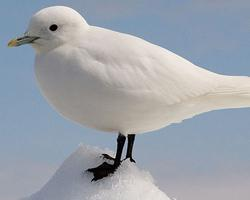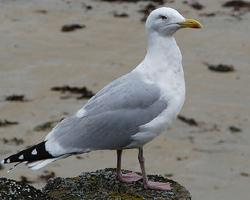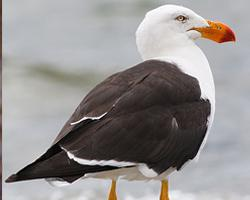
Starea de conservare
| Amenințat |
Descrierea animalului
The Ivory Gull (Pagophila eburnea) is a strikingly beautiful bird, primarily recognized for its pristine, snow-white plumage that serves as a perfect camouflage against the icy landscapes it inhabits. This small to medium-sized gull is a true Arctic specialist, spending the majority of its life within the high Arctic's unforgiving environment, ranging from the northernmost parts of Canada, Greenland, and Spitsbergen, to the high Arctic islands of Russia. The species is unique not only in its appearance but also in its adaptation to one of the most extreme environments on Earth.Adult Ivory Gulls have a pure white body, which is complemented by a pale, bluish-gray bill tipped with yellow and black. Their legs are black, providing a stark contrast to their otherwise snowy appearance. One of the most captivating features of this bird is its eyes, which are dark and encircled by a thin, red orbital ring, adding a touch of color to its otherwise monochromatic appearance. Juvenile Ivory Gulls, in contrast, display a mottled gray and white plumage, which gradually transitions to the adult's white over several years.
With a wingspan of approximately 115 to 135 cm, the Ivory Gull is smaller than many of its gull relatives. Despite its delicate appearance, it is an incredibly resilient species, capable of withstanding the harsh Arctic climate. It nests on the ground, often choosing remote and inaccessible sites on rocky cliffs or islands, laying one to three eggs. Its nesting sites are typically located near the sea ice, which plays a crucial role in the gull's foraging strategy.
The diet of the Ivory Gull is varied and opportunistic, consisting of fish, crustaceans, and small mammals, as well as scavenged carcasses of seals and other marine mammals. Remarkably, this gull is often observed following polar bears and other predators to feed on the remains of their kills, showcasing its adaptability and survival instincts.
Migration patterns of the Ivory Gull are not fully understood, but it is known that while some individuals remain in the high Arctic year-round, others may venture southward during the winter months, occasionally appearing in northern parts of Europe and North America. These sightings, although rare, are always a treat for birdwatchers.
The Ivory Gull is considered a species of conservation concern due to its limited breeding range and the threats posed by climate change. The receding Arctic ice affects its habitat and food sources, posing significant challenges for the species. Additionally, pollution and disturbance at breeding sites further exacerbate the pressures on their populations.
In summary, the Ivory Gull is a remarkable bird, not only for its ethereal beauty but also for its extraordinary adaptations to life in one of the planet's most extreme habitats. Its presence in the Arctic serves as a reminder of the resilience and fragility of polar ecosystems, making it an important species for conservation efforts and a symbol of the wild, untamed beauty of the Arctic.
Animale similare
Fotografii noi cu animale
Top 10 animale
- Dolphin gull (Leucophaeus scoresbii)
- Diana monkey (Cercopithecus diana)
- Moustached guenon (Cercopithecus cephus)
- Greek tortoise (Testudo graeca)
- Stone loach (Barbatula barbatula)
- Galápagos tortoise (Geochelone nigra complex)
- Japanese macaque (Macaca fuscata)
- Russian tortoise (Testudo horsfieldii)
- Common flying dragon (Draco volans)
- Galápagos penguin (Spheniscus mendiculus)


